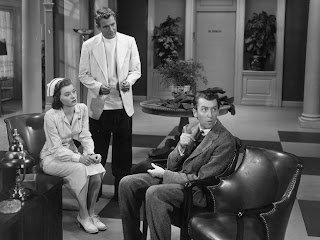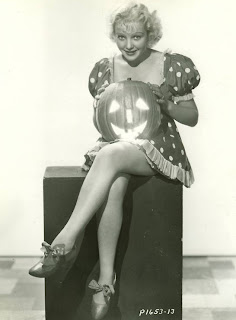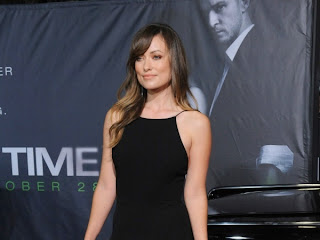 Spencer Tracy, Hedy Lamarr and John Garfield as Pilon, Dolores and Danny in "Tortilla Flat" (1942) directed by Victor Fleming
Spencer Tracy, Hedy Lamarr and John Garfield as Pilon, Dolores and Danny in "Tortilla Flat" (1942) directed by Victor Fleming Tortilla Flat had begun filming on November 23, with Spencer Tracy and Hedy in the leading roles. As added box-office insurance the young stage and film actor John Garfield, born on New York's Lower East Side, was borrowed from Warner Bros. to play Danny. All three incongruously portrayed poor Hispanic Californians living in Northern California.
Tortilla Flat had begun filming on November 23, with Spencer Tracy and Hedy in the leading roles. As added box-office insurance the young stage and film actor John Garfield, born on New York's Lower East Side, was borrowed from Warner Bros. to play Danny. All three incongruously portrayed poor Hispanic Californians living in Northern California.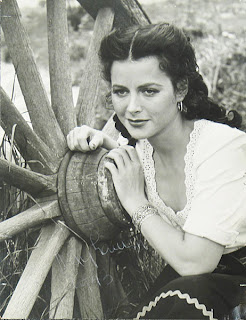 Based on the bestselling 1935 novel by John Steinbeck, with screen adaptation by John Lee Mahin and Benjamin Glazer, Tortilla Flat was assigned to the rugged Metro director Victor Fleming. MGM had bought the rights to the project for $65.000 on April 8, 1940, announcing it as a vehicle for Tracy. Steinbeck, fearing that his beloved paisano characters would be patronized and made quaint, offered to purchase the rights of his story back from MGM for $10.000.
Based on the bestselling 1935 novel by John Steinbeck, with screen adaptation by John Lee Mahin and Benjamin Glazer, Tortilla Flat was assigned to the rugged Metro director Victor Fleming. MGM had bought the rights to the project for $65.000 on April 8, 1940, announcing it as a vehicle for Tracy. Steinbeck, fearing that his beloved paisano characters would be patronized and made quaint, offered to purchase the rights of his story back from MGM for $10.000. At one point, while Hedy Lamarr dragged her heels before accepting the role, MGM had wanted to secure the services of Rita Hayworth, now a huge star at Columbia Pictures, for the part of Sweets Ramirez. (In the original story, Dolores "Sweets" Ramirez was but a minor character. For cinematic purposes, her character's importance was built up).
At one point, while Hedy Lamarr dragged her heels before accepting the role, MGM had wanted to secure the services of Rita Hayworth, now a huge star at Columbia Pictures, for the part of Sweets Ramirez. (In the original story, Dolores "Sweets" Ramirez was but a minor character. For cinematic purposes, her character's importance was built up). The story revolves around the lives of poor, impoverished Mexican paisanos who live in a Norther California coastal fishing village just north of Monterey called Tortilla Flat. Pilon (Spencer Tracy) and Pablo (Akim Tamiroff) are but a couple of the wanderers and scoundrels who populate the village. The other paisanos who follow Pilon, the ringleader, are Portegee Joe (Staten Island-born Allen Jenkins), Jose Maria Corcoran (John Qualen) and Danny Alvarez (John Garfield).
The story revolves around the lives of poor, impoverished Mexican paisanos who live in a Norther California coastal fishing village just north of Monterey called Tortilla Flat. Pilon (Spencer Tracy) and Pablo (Akim Tamiroff) are but a couple of the wanderers and scoundrels who populate the village. The other paisanos who follow Pilon, the ringleader, are Portegee Joe (Staten Island-born Allen Jenkins), Jose Maria Corcoran (John Qualen) and Danny Alvarez (John Garfield). Sweets Ramirez (Hedy Lamarr) is the town beauty.
Sweets Ramirez (Hedy Lamarr) is the town beauty. Unexpectedly Danny (John Garfield) inherits two houses and a watch. He generously rents one of his houses to his pals for $15 a month and keeps the other house for himself. He sells his watch for money to buy wine and rejoins the group in their wasteful laziness. He is soon drawn to the beautiful cannery worker Dolores (Hedy Lamarr).
Unexpectedly Danny (John Garfield) inherits two houses and a watch. He generously rents one of his houses to his pals for $15 a month and keeps the other house for himself. He sells his watch for money to buy wine and rejoins the group in their wasteful laziness. He is soon drawn to the beautiful cannery worker Dolores (Hedy Lamarr). John Garfield enjoyed working with Hedy Lamarr in their love scenes, calling her 'Wild Cat Lamarr', and she relished the opportunity of not having to glamorize her character.
John Garfield enjoyed working with Hedy Lamarr in their love scenes, calling her 'Wild Cat Lamarr', and she relished the opportunity of not having to glamorize her character. Coached by the studio coordinator of speech, Dr. Simon Mitchneck, Hedy was able to pitch her voice down to a lower, middle register, which effectively aided her characterization. In one of Tortilla Flat's scenes, filmed at the fish cannery, Hedy actually worked on a fish-canning line, sweating real sweat and packing real fish. She loved that she was required to be smelly and dirty, and she took special pleasure in doing that particular scene.
Coached by the studio coordinator of speech, Dr. Simon Mitchneck, Hedy was able to pitch her voice down to a lower, middle register, which effectively aided her characterization. In one of Tortilla Flat's scenes, filmed at the fish cannery, Hedy actually worked on a fish-canning line, sweating real sweat and packing real fish. She loved that she was required to be smelly and dirty, and she took special pleasure in doing that particular scene.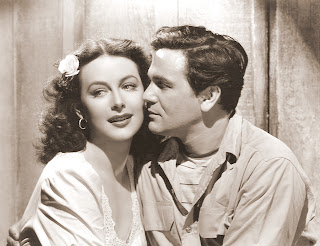 Hedy also enjoyed working with John Garfield. Together they projected remarkable screen chemistry. Hedy took delight in Garfield's stories of riding the rails as a hobo when he was a youngster, before becoming an actor. There was something very Steinbeckian in his persona. Hedy loved adventure, and her romantic fantasies were whetted by Garfield's tales. One particular vignette, when Dolores feeds a sickly baby, is tenderly photographed by Karl Freund.
Hedy also enjoyed working with John Garfield. Together they projected remarkable screen chemistry. Hedy took delight in Garfield's stories of riding the rails as a hobo when he was a youngster, before becoming an actor. There was something very Steinbeckian in his persona. Hedy loved adventure, and her romantic fantasies were whetted by Garfield's tales. One particular vignette, when Dolores feeds a sickly baby, is tenderly photographed by Karl Freund. About her role, Hedy would say later: "It was a honest part... and I was glad to get away from glamour".
About her role, Hedy would say later: "It was a honest part... and I was glad to get away from glamour". Garfield recalls shooting his first scene with Fleming at the helm:
Garfield recalls shooting his first scene with Fleming at the helm: "The director called a halt and shouted: 'For Christ's sake, Garfield, you have to do better than that. I fought like hell to get you in this picture, so don't make me look like a fool'. As Tracy snickered in the background, Fleming railed at Garfield some more and they shot the scene again. "Take it easy, Garfield, don't get too good. A lot of your scenes are with Hedy Lamarr. She's not what you'd call unoutclassable, and we can't let that happen. Let's take it again. Be better than you were the first time, but worse than the second."
 Author John Steinbeck, an acquaintance of Garfield's, had suggested him for the role of Danny in Tortilla Flat. Jack Warner didn't want to let him go. Garfield threatened to leave for Europe as a war correspondent if Warner didn't let him go. The threat may have been an idle one, but Warner gave in, lending Garfield to MGM in return for the services of Hedy Lamarr. Besides, Warner would benefit from the $5,000 per week salary MGM would pay them to use him because Garfield was then earning $2,000 per week for Warners. The studio would pocket the other $3,000 and make a profit of $30,000 over the ten weeks Garfield was at MGM.
Author John Steinbeck, an acquaintance of Garfield's, had suggested him for the role of Danny in Tortilla Flat. Jack Warner didn't want to let him go. Garfield threatened to leave for Europe as a war correspondent if Warner didn't let him go. The threat may have been an idle one, but Warner gave in, lending Garfield to MGM in return for the services of Hedy Lamarr. Besides, Warner would benefit from the $5,000 per week salary MGM would pay them to use him because Garfield was then earning $2,000 per week for Warners. The studio would pocket the other $3,000 and make a profit of $30,000 over the ten weeks Garfield was at MGM. Danny falls for the fiery Dolores. She wants Danny to get a job. "I got no time for work", Danny says, while laying about strumming his guitar. But to impress Dolores he trades in his guitar for a vacuum cleaner, even though her house does not have electricity.
Danny falls for the fiery Dolores. She wants Danny to get a job. "I got no time for work", Danny says, while laying about strumming his guitar. But to impress Dolores he trades in his guitar for a vacuum cleaner, even though her house does not have electricity. In her late days in Florida, Hedy spoke highly of her leading men James Stewart and John Garfield, of whom she had autographed, framed photographs prominently displayed in her living room.
In her late days in Florida, Hedy spoke highly of her leading men James Stewart and John Garfield, of whom she had autographed, framed photographs prominently displayed in her living room. Danny would remain one of Garfield's favorite roles. "Getting something like this, something so real you can reach out and put your hand on it, is like going back to the stage", he told journalist Charles Darnton.
Danny would remain one of Garfield's favorite roles. "Getting something like this, something so real you can reach out and put your hand on it, is like going back to the stage", he told journalist Charles Darnton. He developed a respectful professional relationship with Tracy, who was, along with Cary Grant, the biggest male star he ever worked with in film. For Garfield, Tracy proved to be a good acting partner, for he liked to ad-lib or throw a curve into the scripted dialogue to see what sort of color he could bring to a scene. But the two men would not become friends.
He developed a respectful professional relationship with Tracy, who was, along with Cary Grant, the biggest male star he ever worked with in film. For Garfield, Tracy proved to be a good acting partner, for he liked to ad-lib or throw a curve into the scripted dialogue to see what sort of color he could bring to a scene. But the two men would not become friends.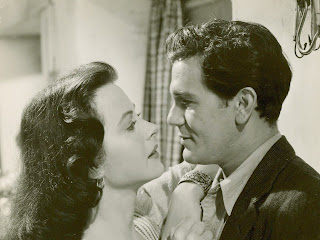 As for Garfield's relationship with the beautiful Hedy Lamarr, perhaps his nickname for her: 'Wildcat', hints at an intimate relationship. Lamarr's rather explicit 1965 autobiography makes no mention of an affair with Garfield, but the on-screen chemistry between the two stars led the Hollywood gossip mill to believe the two were involved.
As for Garfield's relationship with the beautiful Hedy Lamarr, perhaps his nickname for her: 'Wildcat', hints at an intimate relationship. Lamarr's rather explicit 1965 autobiography makes no mention of an affair with Garfield, but the on-screen chemistry between the two stars led the Hollywood gossip mill to believe the two were involved. Tortilla Flat proved to he a very mild commercial success in the spring of 1942. "One of his better performances", Variety's critic said of Garfield's work in the film. It would remind everyone that John Garfield was capable of solid character work, but it still didn't make Warner Bros. want to offer him anything remotely similar.
Tortilla Flat proved to he a very mild commercial success in the spring of 1942. "One of his better performances", Variety's critic said of Garfield's work in the film. It would remind everyone that John Garfield was capable of solid character work, but it still didn't make Warner Bros. want to offer him anything remotely similar. John Garfield would forever consider Tortilla Flat one of his best. "He would always talk about that film", actor Robert Brown, a friend of Garfield's, said. "I knew the song he sang from that film, 'Mrs. Morales' and he and I would go from bar to bar in New York, singing it together".
John Garfield would forever consider Tortilla Flat one of his best. "He would always talk about that film", actor Robert Brown, a friend of Garfield's, said. "I knew the song he sang from that film, 'Mrs. Morales' and he and I would go from bar to bar in New York, singing it together".Sources:
"He Ran All the Way: The Life of John Garfield" by Robert Nott
"Beautiful: The Life of Hedy Lamarr" by Stephen Michael Shearer
